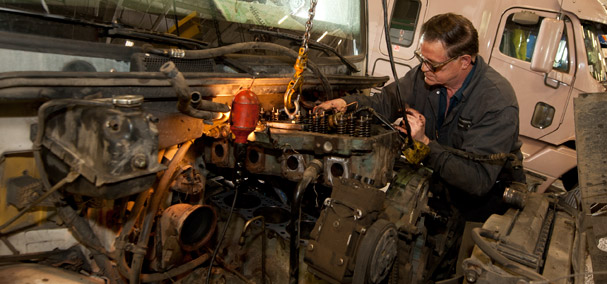If you talk to any experienced truck driver they will tell you that one of the most important things to keeping your business running efficiently is preventative maintenance.
The truth is keeping your truck reliable also means keeping it affordable. Let’s start by putting that in real-world terms.
Take a guess at what the cost would be if you were to blow your engine while under a load? According to OverdriveOnline.com, this costs a staggering $23,000. That includes the repairs, towing, and lost productivity.
That’s a frightening number for any business. There is a little bit of good news though. By staying on top of preventative maintenance you can reduce this cost by as much as 50%.
Here are five tips that will help you to avoid breakdowns, which will help to keep your truck — and your business — up and running for the long haul.
Check your tires
Tire problems account for 25% or more of all truck-related roadside events. Prevent these problems with pre-trip inspections of your:
Tire Pressure – Underinflated tires (more prone to blowouts) and overinflated tires (poor handling) both undermine fuel economy and tire life. Your owner’s manual lists the correct pressure for your specific tires. Trucks made since 2003 display this information on a placard in the driver’s side doorjamb. Remember, truck tires lose about 1 psi of pressure each month. Seasonal temperature changes take an additional 1 psi for every 10 degrees in air temperature.
Tire Wear – Damaged treads, cracks and bald spots are major warning signs. The Federal Motor Carrier Safety Administration (FMCSA) says minimum tread depth for a steer tire is 4/32 of an inch. The Commercial Vehicle Safety Alliance (CVSA) goes further, saying that if tread depth is less than 2/32 of an inch, the truck is taken out of service pending tire replacement.
Make sure your brakes are in tip-top shape
The relentless heat, pressure, and friction absorbed by brakes makes them the second culprit for roadside events. Beware of these six brake system “enemies”:
- Water and contamination in air supply and control system
- Oil passing from compressor
- External contamination and corrosion
- Air pressure leakage
- Brake system pressure and timing imbalance
- Reduced foundation brake performance
Not comfortable or confident in monitoring brakes? Take it to a shop. Nobody’s expecting you to be a mechanic — if any maintenance task seems beyond your comfort level, always employ help.
Monitor your electrical system
Trucks draw serious power. A poorly performing electrical system kills performance and can harm other components, leading to costly repairs. Keep an eye on:
The Battery – Make sure yours is in good condition, has the manufacturer’s recommended capacity, and is fully charged at all times. Defective batteries can damage vital engine parts, or just leave you stranded in the dark.
Wires and Cables – Keep battery cables and wiring connections securely fastened and corrosion-free, helping to prevent shorts, faulty lights, and even major system failures.
Maintain proper oil and engine coolant
There’s no better way to blow your truck’s engine than to slack on properly maintaining the oil and coolant systems. Keep your truck’s maintenance records handy to know when these fluids were checked and serviced. Then, stick to the Original Equipment Manufacturer (OEM) recommended maintenance intervals. A couple of things to keep in mind:
Oil – At major oil change intervals (every 10,000 miles), work with a service center, especially once your used truck has logged 300,000 miles. Pros can give you analysis of how your particular engine may be burning oil, breaking down its viscosity, or operating outside of optimal OEM parameters.
Coolant – Stick to OEM recommendations and go to the pros for major intervals. Take note of what coolant type your engine requires (for example, Extended Life Coolant or conventional coolant). It’s also fairly easy to do a visual inspection. Obtain a coolant sample and inspect it for clarity, color, and debris. Low-cost test strips can indicate antifreeze concentration and additive levels.

Know when it’s time to trade up
Even the best-maintained used truck will eventually wear down. That’s when an owner-operator has to choose between preventive maintenance vs. replacement/upgrade.
OverdriveOnline.com offers a solid rule of thumb. Consider a new purchase when the principal, interest, maintenance and operating costs of an old vehicle are higher than the comparable costs attached to a new vehicle. Detailed service records—including costs—are the best foundation for doing repair vs. upgrade math.
This article was originally featured on Ryder.com.